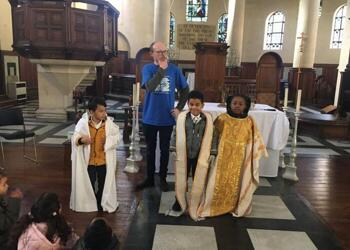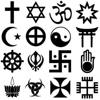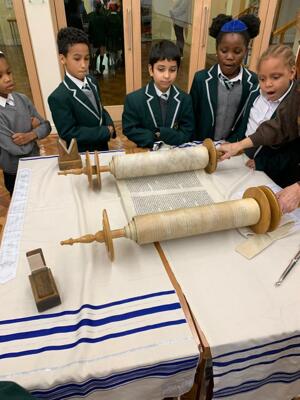Religious Education
Science without religion is lame, religion without science is blind.
Albert Einstein, 1954
Religious Education is used to develop children’s questioning and understanding of the world that they live in. It creates awareness and helps children to understand people’s different religions, cultures, beliefs and practices alongside non-religious beliefs.
It is taught in a way that allows all children to develop a deep understanding of principal religions - Judaism, Christianity, Islam, Buddhism, Hinduism and Sikhi.
There are two main strands as part of our teaching:
-
Learning about other views, beliefs and cultures supports children in developing positive attitudes towards them.
-
Learning from other views, cultures and beliefs supports children in developing their views and beliefs about themselves, their family and community.
 Children will be given the opportunity to explore different religions through stories, drama and an all rounded enriching curriculum. They will look at a number of sacred texts, religious representations and places of worship. Through investigations and explanations, pupils will be able to analyse various religious and non-religious beliefs. Children should be equipped with sufficient knowledge and opportunities to develop an understanding of their personal beliefs.
Children will be given the opportunity to explore different religions through stories, drama and an all rounded enriching curriculum. They will look at a number of sacred texts, religious representations and places of worship. Through investigations and explanations, pupils will be able to analyse various religious and non-religious beliefs. Children should be equipped with sufficient knowledge and opportunities to develop an understanding of their personal beliefs.
DET Curriculum Principles
- The Bigger Picture
Lessons follow a narrative and part of a coherent map which is well sequenced and planned. As a result, students are supported to build schemas in their long-term memory to help retention. Religious Education enables pupils to take their place within a diverse multi-religious and multi-secular society.
- Knowledge Rich
The curricula combine a rich blend of subject knowledge and the related disciplinary skills deepen learning. Acquiring fundamental knowledge and being able to quickly access relevant information from memory are prerequisites for deeper learning and reasoning.
Effective RE comprises:
- substantive knowledge: knowledge about various religious and non-religious traditions ways of knowing: ‘how to know’ about religion and non-religion
- personal knowledge: an awareness of their own presuppositions and values about the religious and non-religious traditions they study
- Literacy Development
Literacy is at the heart of the curriculum and students’ ‘disciplinary literacy’ is prioritised. Vocabulary rich lessons ensure students have the opportunity to develop their vocabulary (including tier 2/3 vocabulary), extending knowledge and helping them to become confident communicators and learners. Students have the opportunity to read appropriately complex texts, break down complex writing tasks, combine writing instruction with reading and use structured talk in order to increase students’ understanding across the curriculum. Where necessary students are provided with individual literacy support in support of the aim for all to leave school with the ability to comprehend and communicate effectively through reading, writing, speaking and listening skills.
Stories are extremely important for children to understand Religious Education as they provoke questions and probing what really matters in different religions. Stories should be used innovatively to give children opportunities to learn about other beliefs, cultures and religions.
to understand Religious Education as they provoke questions and probing what really matters in different religions. Stories should be used innovatively to give children opportunities to learn about other beliefs, cultures and religions.
- Enrichment
Varied experiences enrich lives, engage imaginations, stretch skills and allow students to think creatively and independently.
Children should have a wide variety of opportunities to visit places of worship, interacting with artefacts, engaging with members of faith groups and celebrating festivals.
Early Years
The R.E curriculum begins in our Early Years under ‘Understanding the World’
-
Begin to make sense of their own life-story and family’s history
-
Continue developing positive attitudes about the differences between people.
-
Answer their questions and encourage discussion. Suggestion: talk positively about different appearances, skin colours and hair types.
-
Celebrate and value cultural, religious and community events and experiences.
-
Talk about members of their immediate family and community.
-
Encourage children to share pictures of their family and listen to what they say about the pictures.
-
Using examples from real life and from books, show children how there are many different families.
-
-
Understand that some places are special to members of their community.
-
Name and explain the purpose of places of worship and places of local importance to the community to children, drawing on their own experiences where possible.
-
Take children to places of worship and places of local importance to the community.
-
Invite visitors from different religious and cultural communities into the classroom to share their experiences with children.
-
-
Recognise that people have different beliefs and celebrate special times in different ways.
-
Weave opportunities for children to engage with religious and cultural communities and their practices throughout the curriculum at appropriate times of the year.
-
R.E can contribute to children’s development of characteristics of effective learning in particular with regard to creating and thinking critically and playing and exploring :
-
Making links and noticing patterns in their experiences
-
Showing curiosity about objects, events and people
-
Using senses to explore the world around them
-
Representing their experiences in play
-
Acting out experiences with other people
How is Religious Education taught in The Early Years?
In the EYFS, It is important to encourage children to ask questions and explore answers which can:
-
support children to develop emotionally, spiritually and morally
-
support their developing thinking skills, both abstract and imaginative
-
help them find out about themselves, their family and community
-
help them to develop a sense of place in their family and community, in the world and in the universe
-
help them learn about similarities and differences between themselves and others, and among families, communities and traditions.
Key Stage 1
Knowledge, skills and understanding
Attainment Target 1: Learning about religion
Pupils should be taught to:
-
Explore a range of religious stories and sacred writings and talk about their meanings;
-
Name and explore a range of celebrations,
-
worship and rituals in religion, noting similarities where appropriate;
-
Identify the importance, for some people, of belonging to a religion and recognise the difference this makes to their lives;
-
Explore how religious beliefs and ideas can be expressed through the arts and communicate their responses;
-
Identify and suggest meanings for religious symbols and begin to use a range of religious words.
Attainment Target 2: Learning from religion
Pupils should be taught to:
-
Reflect on and consider religious and spiritual feelings, experiences and concepts such as worship, wonder, praise, thanks, concern, joy and sadness;
-
Ask and respond imaginatively to puzzling questions, communicating their ideas;
-
Identify what matters to them and others, including those with religious commitments, and communicate their responses;
-
Reflect on how spiritual and moral values relate to their own behaviour;
-
Recognise that religious teachings and ideas make a difference to individuals, families and the local community.
Breadth of study
During this key stage, pupils in Lambeth schools should be taught the knowledge, skills and understanding through the following areas of study:
-
Christianity
-
Three other principal religions, one of which is a religious community with a significant local presence
-
Belonging / Who am I?
-
Celebrations
-
Pupils will also bring other faiths and a secular worldview into the discussions in RE where they introduce this from their own experience.
Themes
-
Believing: what people believe about God, humanity and the natural world;
-
Story: how and why some stories are sacred and important in religion;
-
Celebrations: how and why celebrations are important in religion;
-
Symbols: how and why symbols express religious meaning;
-
Leaders and teachers: figures who have an influence on others locally, nationally and globally in religion;
-
Belonging: where and how people belong and why belonging is important; myself: who I am and my uniqueness as a person in a family and community.
Curriculum opportunities
During the key stage, pupils should be offered opportunities that are integral to their learning and enhance their engagement with the concepts, processes and content of the subject.
The curriculum should provide opportunities for pupils to:
-
Visit places of worship and focus on symbols and feelings;
-
Listen and respond to visitors from local faith communities;
-
Use their senses and have times of quiet reflection;
-
Use art and design, music, dance and drama to develop their creative talents and imagination;
-
Share their own beliefs, ideas and values and talk about their feelings and experiences;
-
Begin to use ICT to explore religions and beliefs as practised in the local and wider community.
How is Religious Education taught in KS1?
In Key Stage 1 it is expected that pupils should be studying Christianity, Islam and one other principal religion (Hinduism, Judaism and Sikhism).
At this stage pupils should be able to talk about what they find important to themselves and others. They will also begin to see and understand the importance that religion has to believers, especially other children that are in the class.
In Key Stage 1, teachers may assess the children in their books through:
-
Ordering events
-
Written sentences
-
Cutting and labeling diagrams
They may also assess through
-
Drama that the children can do
-
Freeze framing
Key Stage 2
Knowledge, skills and understanding
Attainment Target 1: Learning about religion
Pupils should be taught to:
-
Describe the key aspects of religions, especially the people, stories and traditions that influence the beliefs and values of others;
-
Describe the variety of practices and ways of life in religions and understand how these stem from, and are closely connected with, beliefs and teachings;
-
Identify and begin to describe the similarities and differences within and between religions;
-
Investigate the significance of religion in the local, national and global communities;
-
Consider the meaning of a range of forms of religious expression, understand why they are
-
important in religion and note links between them;
-
Describe and begin to understand religious and other responses to ultimate and ethical questions;
-
Use specialist vocabulary in communicating their knowledge and understanding;
-
Use and interpret information about religions from a range of sources.
Attainment Target 2: Learning from religion
Pupils should be taught to:
-
Reflect on what it means to belong to a faith community, communicating their own and others’ responses;
-
Respond to the challenges of commitment both in their own lives and within religious traditions, recognising how commitment to a religion is shown in a variety of ways;
-
Discuss their own and others’ views of religious truth and belief, expressing their own ideas;
-
Reflect on ideas of right and wrong and their own and others’ responses to them;
-
Reflect on sources of inspiration in their own and others’ lives.
Breadth of study
During this key stage, pupils in Lambeth schools should be taught the knowledge, skills and understanding through the following areas of study:
-
Christianity;
-
Five other principal religions including religious communities with a significant local presence.
-
How did the World begin?
-
Weddings
-
Peace
-
The End of Life’s Journey;
-
Understanding Faith and Belief in Lambeth.
-
Pupils will also bring other faiths and a secular worldview into the discussions in RE where they
-
introduce this from their own experience
Themes
-
Beliefs and questions: how people’s beliefs about God, the world and others impact on their lives;
-
Teachings and authority: what sacred texts and other sources say about God, the world and human life;
-
Worship, pilgrimage and sacred places: where, how and why people worship, including at particular sites;
-
The journey of life and death: why some occasions are sacred to believers, and what people think about life after death;
-
Symbols and religious expression: how religious and spiritual ideas are expressed;
-
Inspirational people: figures from whom believers find inspiration;
-
Religion and the individual: what is expected of a person in following a religion or belief;
-
Religion, family and community: how religious families and communities practice their faith, and the contributions this makes to local life;
-
Beliefs in action in the world: how religions and beliefs respond to global issues of human rights, fairness, social justice and the importance of the environment.
Curriculum opportunities
During Key Stage 2, pupils should be offered opportunities that are integral to their learning and enhance their engagement with the concepts, processes and content of the subject.
The curriculum should provide opportunities for pupils to:
-
Encounter religion through visitors and visits to places of worship, and focus on the impact and reality of religion on the local and global community;
-
Discuss religious and philosophical questions, giving reasons for their own beliefs and those of others;
-
Consider a range of human experiences and feelings;
-
Reflect on their own and others’ insights into life and its origin, purpose and meaning;
-
Express and communicate their own and others’ insights through art and design, music, dance, drama and ICT;
-
Develop the use of ICT, particularly in enhancing pupils’ awareness of religions and beliefs globally.
How is Religious Education taught in KS2?
Children are expected to learn about Christianity, Islam, Buddhism, Sikhi, Judaism and Hinduism. Children should be expanding on their knowledge from Key Stage 1. They are expected to start making connections between the different religions and start to make sense of sacred texts.
Assessing these children could be done in a number of ways:
-
Their interpretation of texts
-
Comprehension
-
Essays
-
Written paragraphs
-
Drama- freeze framing, hot seating



